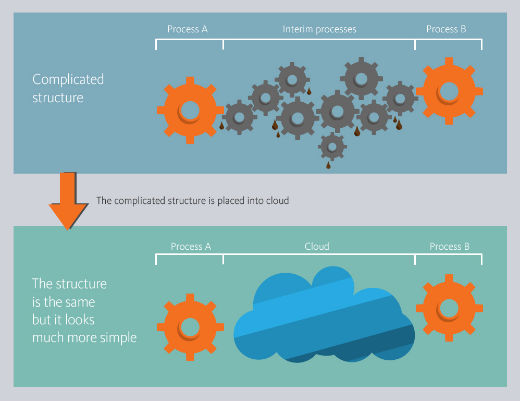 BUSINESS CASE
BUSINESS CASE

Preview
Nowadays there is a lot of hype concerning the term “cloud” in IT-world. Many horns have been locked over definitions of the word “cloud”, but rather standard one is the definition given by NIST. In a few words clouds are an abstraction level between consumers of IT-services and IT-infrastructure that enhances efficiency and manageability of these services providing.
Private Cloud – is one of cloud infrastructure subtypes that allows providing services of IT-department (or outsource IT-company) to users inside the organization. Generally such approach use one of two service models: Software as a Service (SaaS) or Infrastructure as a Service (IaaS).
- Software as a Service means providing software such as mail, file storage, web-sites, etc. without user control over such entities as servers, free space on file storages and so on.
- Infrastructure as a Service provides access to virtual machines and computing power as a service. IaaS is a lower level of abstraction and is more useful for such users as software developers or IT-department itself.
Reasons
Often IT-department is perceived as a wasteful department though in practice just this department provides basis for effective work of present day organization. The problem is that commonly only expenditures for IT-infrastructure are taken into account and its services cannot be counted. This fact disturbs not only IT-department for which it is difficult to prove new expenses for development and maintenance of systems but also users for which it is difficult to receive service of required quality in time. Moreover this approach results in inefficient usage of available resources.
Several cases of unfortunate situations with which organizations that do not use flexibility and manageability of cloud infrastructure can meet.
- Chief accountant reports that 1C server works slowly. It takes place only during accounting periods but impedes work. Administrator of 1C server only throws up his hands – procurements of new hardware are not included in the budget for development. Accounting department allocates funds for buying new advanced server for 1C software. Several months later when new server arrives it is cleared out that administrators are occupied with infrastructure recovery after disk storage failure and they have not time to configure new server. After the server has been installed computers of accounting department should be reconfigured but user support department is overloaded with solving minor users’ problems, so process of configuring parameters will drag on.
- At the same time advertising department begins promotional campaign of the organization’s web-site. Load on the site increases but as the server resources are limited, clients using the site receive errors when they try to order products at the site. Unfortunately buying new server does not make sense – by the time when it has been ordered, delivered and configured, number of clients will have decreased. On the other hand in the meantime the organization has several virtualization servers which are almost not used. These servers were bought for the needs of development department at the stage of application testing but now the servers are not required by the developers. But the development department does not permit to allocate those servers for another purpose because in a month new application version will be released and these resources will be required again.
- When the problem of budget allocation comes up, it is cleared up that IT-department requires budgets for renewal of vendor’s disk storage support, user support staff increases and procurements of several new servers in case that they are required. However given that advertising department blames IT-department for sluggishness and failure of advertising campaign and accounting department is still having troubles with slow systems when working, IT-department has little chance for success.
Advantages and results
The main advantages of private cloud are following:
- On-demand self-service – service consumer can order required services (virtual machines, server time, and disk storage) without interacting with each service provider. It cuts the time of service receiving to large extent and simplifies this process. Furthermore automation of service providing allows reaching steady and measurable quality level.
- Resource pooling – automated managing and allocating resources among different users for providing their most efficient usage and separating among users so that they do not interfere each other. This allows more functional usage of available resources without reducing service quality level.
- Rapid elasticity – resources are allocated on demand and are released when they are not required (often automatically). In this case service consumer gets the impression that resources are unlimited.
- Measured service – capability to measure resource consumption of different consumers (users or departments). Definitely it is one of the main advantages of private cloud. Data on resource consumption can be used for further issuing internal invoices and planning future infrastructure development that in its turn results in more efficient development and costs optimization.
You can find out more about profits that can be provided by cloud infrastructure in your case by filling in this form.
